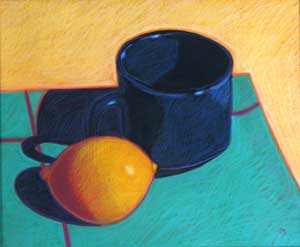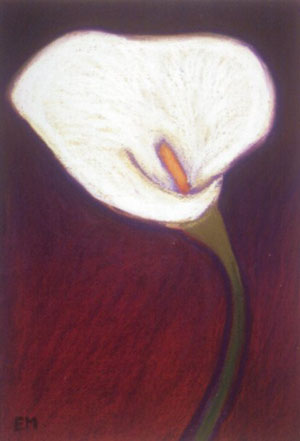Pastels



When I first got married I was working with oils and doing abstract paintings. Then we started to have children. I quickly found out that you could not care for an infant, change diapers, heat bottles, and do whatever while I had my hands soiled with paint. Like it or not I had to give up painting. I filled the creative vacuum with photography. When we would take the kids and the dog for a walk to the park, I would bring my camera and do close up photography of peeling bark on the eucalyptus trees and the peeling paint on the playground equipment. These photos became my way of still doing abstract art.
As the kids got older I was able to start doing some pen and ink work. Using a rapidograph was easy set-up and no clean up when I was finished. While I was in school I enjoyed drawing more than painting so this was a natural follow-up for me. This worked great for a while but I really missed using color. I tried using colored pencils, for a while, but I just didn’t like the results that I was getting. Then I tried giving pastels a try. Pastels have an easy set-up and clean up is minimal, what’s not to like?
When I first started using them, I HATED THEM! As a painter I was used to mixing the colors that I wanted. With pastels, I wasn’t able to rub two sticks together and get the color I wanted. I was frustrated and felt like a beginner but I am stubborn enough I wasn’t going to let them beat me. I promised myself that once I was successful and learned to use them I would throw them away. Well, it took me over 10 years to stop using them. During that time, I used pastels exclusively. I found out they were a truly rich and expressive medium. They also worked well while dealing with my young children and working full time outside the house.
Now, I don’t use them so much and that’s kind of sad. For all of the good qualities there were a number of problems with them. Framing was one of the biggest factors. Not only did I have to cut mats but also the mats had to be floated (have a spacer put behind it). Also, only glass could be used not plexi-glass. When plexi-glass gets cleaned, it creates a static charge and literally will draw some of the pastel off of the surface. Not only did it add extra expense but also it created problems in shipping. And it never failed that when someone was looking to buy the painting, more often than not, I was asked how much it was without the frame.
Now to take their place I use oil pastels or a wonderful water-soluble artist crayon made by Caran D’Arch that works much the same way as the oil pastel. There are no dust problems, framing is easier, and I can get similar effects. The two brands oil pastels that I prefer are the Neo Pastel made by Caran D’Arch and the ones made by Holbein, specifically the ones where each color has 5 different tones. They both have a rich buttery quality and are a pleasure to use.
In the above paintings, the blue mug with a lemon is done in traditional soft pastel, the calla lily is done with artist crayon, and the pear is done with oil pastel.


1 Comments:
Hi Ed, I love pastels! But it also took me awhile to get into them, for me the texture of the dust on my hands and the sound of them scratching the paper or panel drove me absolutely crazy! Now I miss them, I don't have enough room to set them up comfortably in my studio and like you, I find the whole framing thing frustrating, not to mention expensive. I have some oil pastels, oils sticks, etc maybe I should try them again sometime. I like the lily best, the others are nice too.
Post a Comment
<< Home